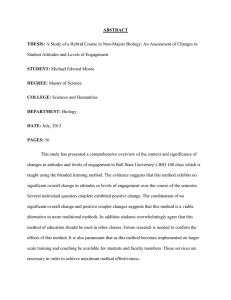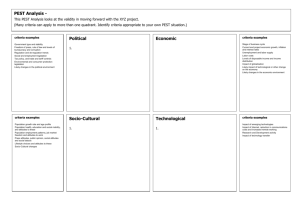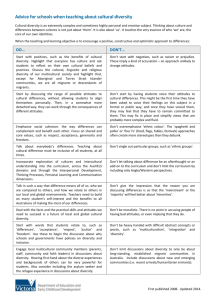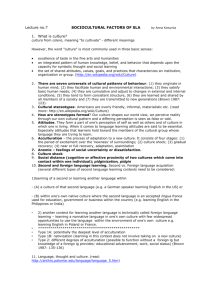Teaching Older Adults to Use Technology with the
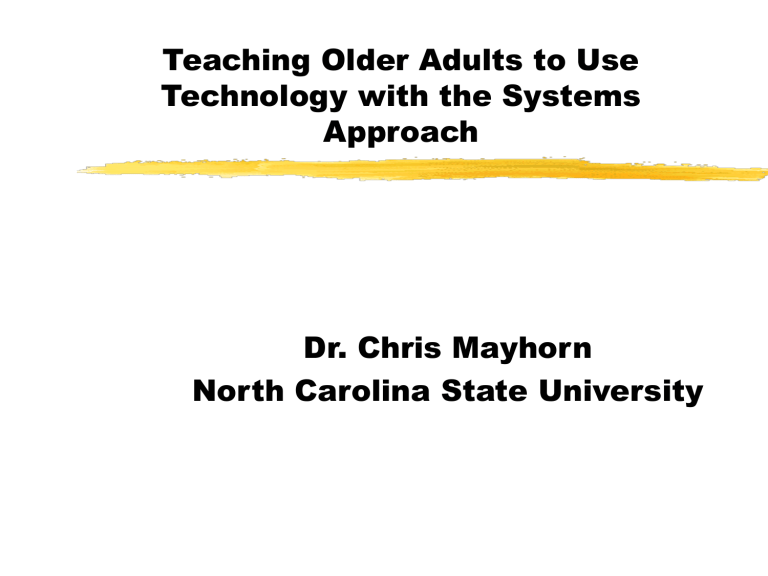
Teaching Older Adults to Use
Technology with the Systems
Approach
Dr. Chris Mayhorn
North Carolina State University
Acknowledgments
Thanks to my co-authors (Aideen J. Stronge,
Anne Collins McLaughlin, and Wendy A. Rogers) from the Georgia Institute of Technology.
This research was supported in part by a grant from the National Institutes of Health (National
Institute on Aging) Grant P01 AG17211 under the auspices of the Center for Research and
Education on Aging and Technology
Enhancement (CREATE).
The Need for Computer
Training
Older adults are aware of the benefits associated with computer use (Morrell,
Mayhorn, & Bennett, 2000).
They are actively seeking computer training programs (Czaja, 1997; Rossman,
2002).
Training programs designed for older adults must meet their specialized needs.
The Systems Approach to
Training
Needs
Assessment
Task Analysis Person Analysis
Modulating
Variables-
Age, Competence,
Experience,
Motivation, Self-
Efficacy, Sex
Knowledge
Skills
Abilities
Perf ormance
Requirements
Selection and Design of Training Program(s)
Training Principles
Previous Training Programs
Previous Research
Evaluation
Development of Criteria
Usability
Transfer and Retention
Training Program
Recommendations
Elaborating with User Input from
Structured Interviews
Older adults (mean age = 71.6) were recruited from a community senior center.
They had recently completed an introductory course in basic computer skills that met three hours each week for six weeks.
Structured interviews were conducted to gain an understanding of course-specific issues, the problems experienced while interacting with computers, and the solutions (strategies) developed to solve these problems.
Needs Assessment
Older adults are demanding to learn about technology
(Adler, 2002) yet they want training before they will use new technology (Rogers, Cabrera, Walker,
Gilbert, & Fisk, 1996).
The goals of the older adult student must be understood and assimilated into the structure of a training program by addressing what older adults want to learn about computers and why. (Baron, D-
Amico, Sissons, & Peters, 1996).
Goals of Students
Enhancing social interaction: “a lot of the grandparents, they are e-mailing their grandchildren”
Searching for information
: “you can hardly do anything with the stock market without a computer”
Remaining active
: “everyone is into computers, if you are not into computers then you are just kind of left out”
Promoting life satisfaction
: “I am just doing it for fun
Task Analysis
Method useful in identifying the procedures and knowledge required to complete a given task.
A task analysis may highlight particular problem areas for students by identifying problematic steps in the procedures where errors occur.
Training programs should be able to instruct users on how to avoid errors and what to do if they happen.
Person Analysis
Difficulties in acquiring computer skills may be associated with a number of factors such as computer attitudes, perceptual ability, and motor function.
Previous computer experience, computer anxiety, and perceived usefulness may interact to influence the development of older adults’ attitudes towards computers.
Attitudes, Perception, and
Motor Function
Training must reduce initial computer anxiety:
Participants were initially worried that they
“might break it [the computer].”
Effects of visual problems can be reduced:
Participants changed the settings on the computer by “making the type size larger” and
“angled the screen” to reduce glare.
Mouse control problems can be accomodated: strategies included altering the speed of the mouse clicks or practicing by playing solitaire.
Selection and Design of
Training Program
Development of the optimal design for a computer training program should be informed by:
the previous stages of the systems approach
prior research that investigated how best to train older adults to use computers.
Evaluation of Training methods
Performance criteria include:
Usability (performance and satisfaction measures that generally reflect the effectiveness of the training experience)
Transfer (skills learned in the classroom can be used in other environments such as the home)
Retention (benefits of training should be maintained over time following the completion of training)
Student Recommendations to Improve Course
Logistics: small class size with “no more than 10 people” who have the same level of computer experience
Course Content:
Focused on goals of student: not focused on the
“agenda [of the instructor] who was trying to cover everything.”
Slow-paced: “the material was [presented] really fast with too much stuff [being covered] for the length of time”
Accompanied by supplemental reference material:
“instructions should be written down so you can take it home and work on it on your own”
Conclusions
One untapped resource for course developers is the older student.
Older adults readily identified very specific goals.
The inclusion of these course objectives is essential for reducing anxiety, maintaining students’ motivation to learn, and promoting positive attitudes.
Instructors of computer training programs can apply the systems approach to tailor their classes to meet the needs of older adults.



